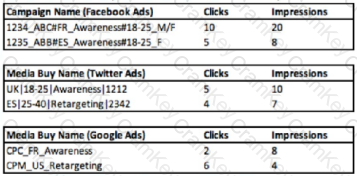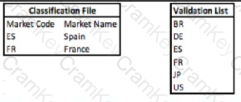Salesforce Marketing Cloud Intelligence Accredited Professional Exam
Last Update Apr 14, 2025
Total Questions : 63
To help you prepare for the Marketing-Cloud-Intelligence Salesforce exam, we are offering free Marketing-Cloud-Intelligence Salesforce exam questions. All you need to do is sign up, provide your details, and prepare with the free Marketing-Cloud-Intelligence practice questions. Once you have done that, you will have access to the entire pool of Salesforce Marketing Cloud Intelligence Accredited Professional Exam Marketing-Cloud-Intelligence test questions which will help you better prepare for the exam. Additionally, you can also find a range of Salesforce Marketing Cloud Intelligence Accredited Professional Exam resources online to help you better understand the topics covered on the exam, such as Salesforce Marketing Cloud Intelligence Accredited Professional Exam Marketing-Cloud-Intelligence video tutorials, blogs, study guides, and more. Additionally, you can also practice with realistic Salesforce Marketing-Cloud-Intelligence exam simulations and get feedback on your progress. Finally, you can also share your progress with friends and family and get encouragement and support from them.
A client has integrated data from Facebook Ads. Twitter ads, and Google ads in marketing Cloud intelligence. For each data source, the source, the data follows a naming convensions as …
Facebook Ads Naming Convention - Campaign Name:
CampID_CampName#Market_Object#object#targetAge_TargetGender
Twitter Ads Naming Convention- Media Buy Name
MarketTargeAgeObjectiveOrderID
Google ads Naming Convention-Media Buy Name:
Buying_type_Market_Objective
The client wants to harmonize their data on the common fields between these two platforms (i.e. Market and Objective) using the Harmonization Center. Given the above information, which statement is correct regarding the ability to implement this request?
wet Me - Given the above information, which statement i 's Correct regarding the ability to implement this request?
A client has integrated data from Facebook Ads, Twitter Ads, and Google Ads in Marketing Cloud Intelligence. For each data source, the data
follows a naming convention as shown below:
Facebook Ads Naming Convention - Campaign Name:
Camp|D_CampName#Market_Objective#TargetAge_TargetGender
Twitter Ads Naming Convention - Media Buy Name:
Market|TargetAge|Objective|OrderID
' Google Ads Naming Convention - Media Buy Name:
Buying Type_Market_Objective
The client wants to harmonize their data on the common fields between these two platforms (i.e. Market and Objective) using the Harmonization ‘Center.
In addition to the previous details, the client provides the following data sample:


Logic specification:
If a value is not present in the Validation List, return “Not Valid”
If a value is not present in the Classification File, return “Unclassified”.
If the Harmonization center is used to harmonize the above data and files, what table will show the final output?
A)

B)

C)

D)

A technical architect is provided with the logic and Opportunity file shown below:
The opportunity status logic is as follows:
For the opportunity stages “Interest”, “Confirmed Interest” and “Registered”, the status should be “Open”.
For the opportunity stage “Closed”, the opportunity status should be closed Otherwise, return null for the opportunity status.

Given the above file and logic and assuming that the file is mapped in a generic data stream type with the following mapping
“Day” — Standard “Day” field
“Opportunity Key” > Main Generic Entity Key
“Opportunity Stage” + Generic Entity Key 2
A pivot table was created to present the count of opportunities in each stage. The pivot table is filtered on Jan 7th - 11th. Which option reflects the stage(s) the Opportunity key 123AA01 is associated with?